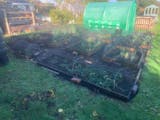*We offer this course at half price with the purchase of any full-length course/the course bundle, plus 60% off any online course for students in full-time education. For information on all the online courses we offer, please see this page.
Please contact Anna, anna@charlesdowding.co.uk, for discount requests/further info.
In the Pests section of this short course, I explain how to reduce the likelihood of pests becoming problematic, even how to prevent them. Because most plants, at some stage in their lives, will meet a pest, or several. This will affect the amount and quality of harvest, sometimes to zero, which can be so disheartening!
This information will enable and empower you to understand and manage the likely pests you will encounter when growing food. Understandings are important because they build an appreciation of how plants grow, and how they fit into the wider ecosystem.

Knowledge is key, the vital first step. Being aware of potential problems enables you to reduce damage from the start, before pests even arrive. This pack will help you to know what you are looking for, and when.
What we call pests are part of the soil food web and insect/animal life in general. I explain common and different ones in each season of growth, those you might expect to appear. Then how to prevent or reduce them, simply and effectively.
Occasionally the pressure on plant growth becomes too much. Significantly damaged plants may be salvageable, but sometimes it’s good to cut your losses.
Here are some examples of preventing too much damage:
- Time your sowings to make it more likely that plants grow when pests are in small numbers.
- Care for your plants in such a way that pests are less common and find them less interesting.
- Lay covers over those plants you know are likely to meet many pests in the upcoming few weeks.
You never need to use synthetic chemicals. Some would call my approach ‘organic’, but it’s more than that. Tune into nature and learn methods from her, so that you can grow plants as healthily as possible.
The information is for reference more than reading all at once. It’s split into shorter sections so that you can access what you need, quickly and easily.
Pests content – includes text, photos and videos
- Introduction
- Animals and birds
- Insects 1: Introduction to insects; ants and aphids
- Insects 2: Cabbage root fly, carrot root fly, caterpillars of butterflies and moths, earwigs and flea beetles
- Insects 3: Gall/swede midges, gnats, leek moths, miners, red spider mites, weevils and woodlice
- Slugs
- Soil grubs: Chafers, cutworms, eelworms, leatherjackets, flatworms, vine weevils and wireworms
- Covers for pest protection

The Diseases section of the course will help you understand and manage the likely diseases you will encounter when growing food. You’ll learn which diseases to worry about! And at what stage of growth.
Understanding diseases helps with an appreciation of how plants manage their growth. Many diseases are part of the natural growth cycle.
Almost every plant, at some stage in its life, will be affected by disease(s). Some make little difference to growth. Other diseases affect the amount and quality of harvest, to varying degrees.
The vegetables we know and grow are sometimes unnatural plants, bred for specific harvests. And we may grow them slightly out of season. This makes them more vulnerable to nature’s ‘corrections’.
Knowledge is key, the vital first step. Being aware of potential problems enables you to reduce damage from the start, before diseases even arrive. You can also then nip problems in the bud, by learning the first signs of perhaps greater damage ahead.
I explain what to do if the pressure on plant growth becomes too much. Often a dire-looking situation is salvageable, but sometimes it’s good to cut your losses.
I also explain how to reduce the likelihood of diseases becoming problematic, even how to prevent them happening.

Here are some examples:
- Improve the quality of your soil to make plant growth stronger, building health instead of fighting disease.
- Morning watering reduces mildew compared to in the evening, and learn not to over-water.
You never need to use synthetic chemicals. Some would call my approach ‘organic’ but I would say it’s more than that. Tune into nature and learn methods from her, so that you can grow plants as healthily as possible.
The information is for reference more than reading all at once. It’s split into shorter sections so that you can access what you need, quickly and easily.
Diseases content – includes text, photos and videos
- Intro
- Diseases 1: Alternaria leaf spot, bacterial soft rot, blackleg, canker of parsnips, clubroot, damping off, fusarium wilt, germination – poor
- Diseases 2: Late blight (potatoes, tomatoes), mildew (cucurbit downy and powdery mildew, lettuce downy and powdery mildew, onion downy mildew, pea powdery mildew)
- Diseases 3: Rust, septoria, verticillium wilt, viruses (cucumber mosaic virus), white rot


















































